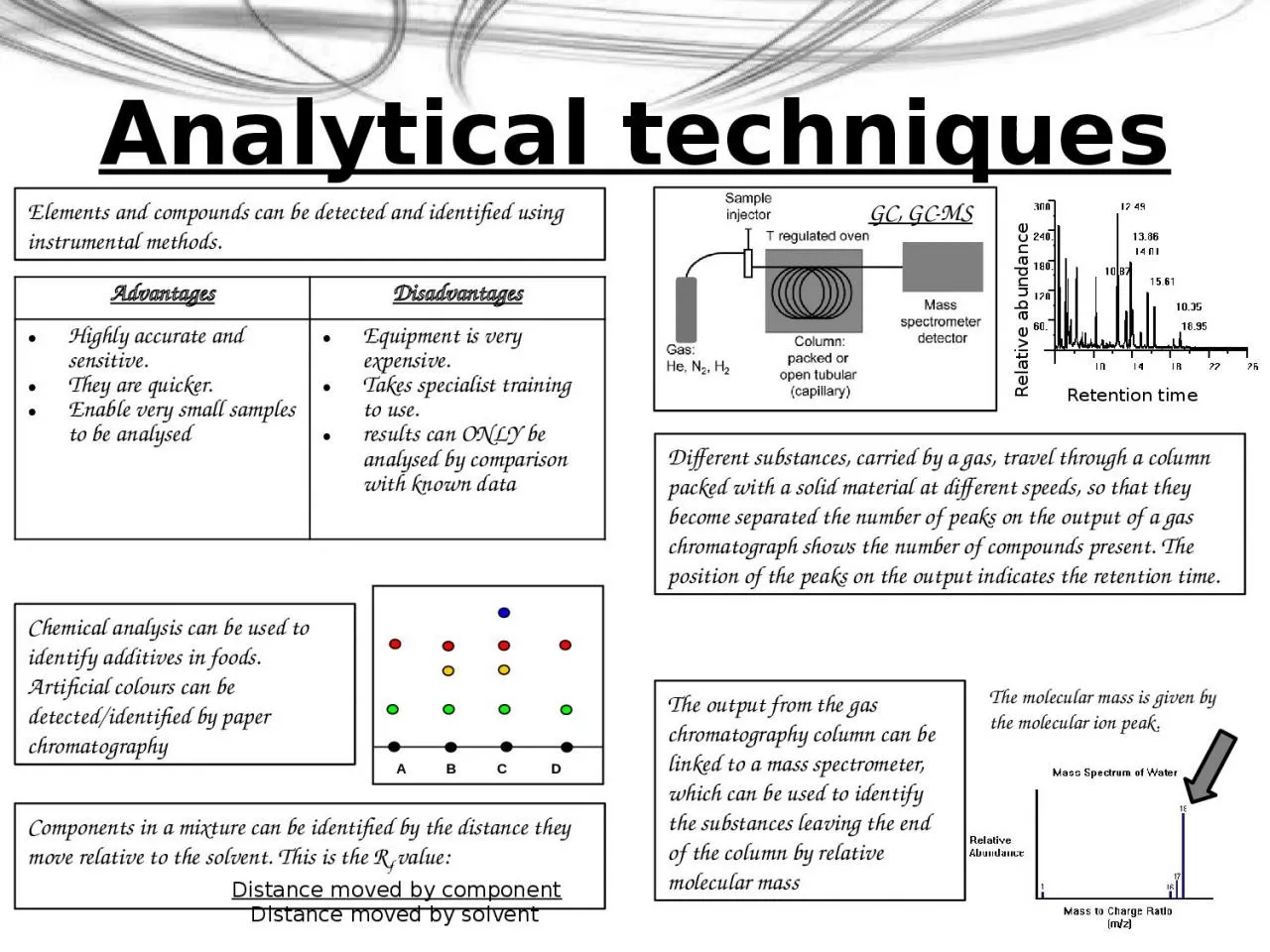

Different substances carried by a gas travel through a column packed with a solid material at different speeds so that they become separated the number of peaks on the output of a gas chromatograph shows the number of compounds ID: 1043299
Download Presentation The PPT/PDF document "Analytical techniques Elements and compo..." is the property of its rightful owner. Permission is granted to download and print the materials on this web site for personal, non-commercial use only, and to display it on your personal computer provided you do not modify the materials and that you retain all copyright notices contained in the materials. By downloading content from our website, you accept the terms of this agreement.
1. Analytical techniquesElements and compounds can be detected and identified using instrumental methods.Different substances, carried by a gas, travel through a column packed with a solid material at different speeds, so that they become separated the number of peaks on the output of a gas chromatograph shows the number of compounds present. The position of the peaks on the output indicates the retention time. AdvantagesDisadvantagesHighly accurate and sensitive.They are quicker.Enable very small samples to be analysedEquipment is very expensive.Takes specialist training to use.results can ONLY be analysed by comparison with known dataChemical analysis can be used to identify additives in foods. Artificial colours can be detected/identified by paper chromatographyA B C DComponents in a mixture can be identified by the distance they move relative to the solvent. This is the Rf value:Distance moved by componentDistance moved by solventRetention timeRelative abundanceGC, GC-MSThe output from the gas chromatography column can be linked to a mass spectrometer, which can be used to identify the substances leaving the end of the column by relative molecular massThe molecular mass is given by the molecular ion peak.
2. 10 QuestionsAnalytical techniquesHow can you separate…A solid from a liquidA liquid from a gasA liquid from a liquidWhat is an E-number?State one advantage and one disadvantage of chromatography.What do we call the filter paper after the chromatography experiment has ended?What colours are present in blank inks?What does the Rf value represent?What do the initials GC-MS stand for?Give an example of a typical carrier gas in a GC-MS.What is the period of time a gas remains in the column of a GC-MS called?Give a use for chromatography.
3. Analytical techniques(a) Filtering(b) take the lid off(c) chromatographyCodes for chemicals which can be used as food additives for use within the EU.Advantages:Highly accurate and sensitive.They are quicker.Enable very small samples to be analysedDisadvantages:Equipment is very expensive.Takes specialist training to use.results can ONLY be analysed by comparison with known data.ChromatogramAll coloursDistance compound travels up chromatogramGas Chromatography – Mass SpectrometryHe (or) N2 (or) H2Retention timeSeparating a mixture of liquids (or) Money and cheques can be proven as fakes using this scientific technique - othersMark SchemeCalculations and molesThe relative formula mass of a substance, in grams, is known as one mole of that substance.35.5Na2O = (2xNa) + (1xO) = (2x23) + (1x16) = 46 + 16 = 62% of Na = (46/62) x 100 = 74.2%Mr of (NH4)2SO4 = 132% of O = (64/132) x 100 = 48.5%The amount of a product obtained is known as the yield.MgCO3 MgO + CO2(24+12+48) (24+16)84g 40g42g 20gYield = (18/20) x 100 = 90% C H 75/12 25/1 6.25 25 1 4 CH4